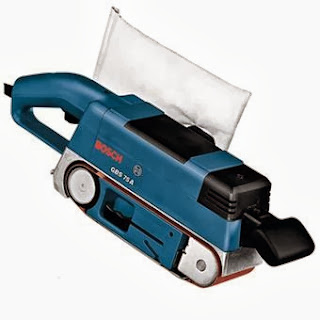How It Works
Regardless of size, all belt sanders operate on the same principle: a loop of sandpaper wraps around a rear roller and a front roller, creating tension between the two. When the sander is switched on, the rear drive roller (which is usually connected to the motor) spins, causing the sanding belt to move forward like the tread of a bulldozer. This is far more aggressive than an orbital sander, in which the sanding pad rotates in a very small circle. But belt sanders can take on far bigger jobs: old layers of paint can disappear with one swipe of the tool, and a wide piece of wood can be leveled smooth with just a few passes.All About Size
Sanding belts typically range from 3 inches wide by 18 to 21 inches in circumference to 4 inches by 24 inches for large models. Smaller belt sanders have also begun to appear on the market. Some feature belts just over 1 inch wide, with a front roller that's smaller than the rear roller. This narrows the point of the belt, making it easier to control and maneuver into hard-to-reach areas, such as the gaps between railing posts on an outdoor deck. Despite the tame appearance of these smaller tools, they're still wild at heart and can easily damage wood if you don't keep them in motion.Dealing with Dust
Belt sanders generate a lot of dust which is a health hazard, especially when you're sanding pressure-treated wood or wood whose surface contains lead-based paint. Dust bags attached to the tools help to gather up the sawdust and reduce the amount that floats in the air or clogs up the grit on the sanding belt. The highest-quality belt sanders can be hooked up directly to shop vacuums, which suck away all the dust. This system keeps the belt cleaner, and you'll get more mileage out of it as a result. (See our guide on dust collectors.)Speed and Slippage
Some sanders are equipped with variable-speed controls. Although professionals may not need this capability, homeowners may find it a plus because it will help them slow things down until they develop good control of the tool. The belts themselves have a tendency to wander slightly off the rollers, so you may need to reposition them occasionally. Some have a tracking knob that you can turn to slide the belt back into place; others have tracking devices that do this automatically.Grit
Coarse or Fine?: All sanding belts sanding belts contain grit in varying degrees of coarseness that are attached by resin to a cloth or paper surface. They range from 24 grit the coarsest to a fine 320. The belts themselves can be made of paper, but paper tears more easily and has a shorter life span than cloth-based alternatives.The grit used in the most economical belts is made from aluminum oxide; these belts are good for all-purpose wood sanding. Belts covered with grit made from ceramic aluminum oxide don't wear out as quickly but not surprisingly, they cost more. In addition, belts come in two varieties of grit closed-coat and open-coat. The grit of closed-coat belts is compacted tightly in the resin, which is good for use on metal or on hardwoods that don't tend to produce gummy dust. On open-coat belts, the grit is spaced out to cut down on clogging. Choose open-coat belts if you're sanding resinous softwoods such as pine, or woods that have painted surfaces.
